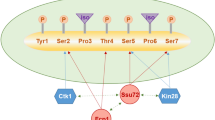Abstract
Phosphorylation status of RNA polymerase (RNAP) II’s largest subunit C-terminal domain (CTD) plays an important role during transcription cycles. The reversible phosphorylation mainly occurs at serine 2 and serine 5 of CTD heptapeptide repeats and regulates RNAP II’s activity during transcription initiation, elongation and RNA processing. Here we expressed and characterized HSPC129, a putative human protein bearing a CTD phosphatase domain (CPD). PCR analysis showed that it was ubiquitously expressed. HSPC129ΔTM, the truncate HSPC129 with first 156 N terminal amino acids deleted, exhibited Mg2+ dependent phosphatase activity at pH 5.0. Its specific CTD phosphatase activity was verified in vitro. Our research suggests that HSPC129 may regulate the dynamic phosphorylation of RNAP II CTD.





Similar content being viewed by others
References
Sayre MH, Tschochner H, Kornberg RD (1992) Reconstitution of transcription with 5 purified initiation-factors and RNA polymeraseII from Saccharomyces-cerevisiae. J Biol Chem 267:23376–23382
Corden JL, Cadena DL, Ahearn JM et al (1985) A unique structure at the carboxyl terminus of the largest subunit of eukaryotic RNA polymeraseII. Proc Natl Acad Sci USA 82:7934–7938
Dahmus ME (1996) Reversible phosphorylation of the C-terminal domain of RNA polymeraseII. J Biol Chem 271:19009–19012
Goodrich JA, Tjian R (1994) Transcription factors IIE and IIH and ATP hydrolysis direct promoter clearance by RNA-polymerase II. Cell 77:145–156
Shatkin AJ, Manley JL (2000) The ends of the affair: capping and polyadenylation. Nat Struct Biol 7:838–842
Ahn SH, Kim M, Buratowski S (2004) Phosphorylation of serine 2 within the RNA polymeraseII C-terminal domain couples transcription and 30 end processing. Mol Cell 13:67–76
Ho CK, Shuman S (1999) Distinct roles for CTD Ser-2 and Ser-5 phosphorylation in the recruitment and allosteric activation of mammalian mRNA capping enzyme. Mol Cell 3:405–411
Rodriguez CR, Cho EJ, Keogh MC et al (2000) Kin28, the TFIIH-associated carboxy-terminal domain kinase, facilitates the recruitment of mRNA processing machinery to RNA polymerase II. Mol Cell Biol 20:104–112
Hengartner CJ, Myer VE, Liao SM et al (1998) Temporal regulation of RNA polymeraseII by Srb10 and Kin28 cyclin-dependent kinases. Mol Cell 2:43–53
Zhou M, Halanski MA, Radonovich MF et al (2000) Tat modifies the activity of CDK9 to phosphorylate serine 5 of the RNA polymeraseII carboxyl-terminal domain during human immunodeficiency virus type 1 transcription. Mol Cell Biol 20:5077–5086
Lu H, Zawel L, Fisher L et al (1992) Human general transcription factor II H phosphorylates the C-terminal domain of RNA polymeraseII. Nature 358:620–621
Komarnitsky P, Cho EJ, Buratowski S (2000) Different phosphorylated forms of RNA polymerase II and associated mRNA processing factors during transcription. Genes Dev 14:2452–2460
Corden JL (1990) Tails of RNA polymerase-II. Trends Biochem Sci 15:383–387
Kang ME, Dahmus ME (1993) RNA polymerase-II A and polymerase-II O have distinct roles during transcription from the TATA-less murine dihydrofolate-reductase promoter. J Biol Chem 268:25033–25040
Chambers RS, Dahmus ME (1994) Purification and characterization of a phosphatase from HeLa cells which dephosphorylates the C terminal domain of RNA polymerase II. J Biol Chem 269:26243–26248
Yeo M, Lin PS, Dahmus ME et al (2003) A novel RNA polymerase II C-terminal domain phosphatase that preferentially dephosphorylates serine 5. J Biol Chem 278:26078–26085
Zheng HR, Ji CN, Gu SH et al (2005) Cloning and characterization of a novel RNA polymerase II C-terminal domain phosphatase. BBRC 331:1401–1407
Lin PS, Dubois MF, Dahmus ME (2002) TFIIF-associating carboxyl-terminal domain phosphatase dephosphorylates phosphor-serines 2 and 5 of RNA polymerase II. J Biol Chem 277:45949–45956
Kamenski T, Heilmeier S, Meinhart A et al (2004) Structure and mechanism of RNA polymerase II CTD phosphatases. Mol Cell 15:399–407
Zhang QH, Ye M, Wu XY et al (2000) Cloning and functional analysis of cDNAs with open reading frames for 300 previously undefined genes expressed in CD34+ hematopoietic stem/progenitor cells. Genome Res 10:1546–1560
Kemmer D, Podowski RM, Arenillas D (2006) NovelFam3000-uncharacterized human protein domains. BMC Genomics 7:1471–2164
Peterson SR, Dvir A, Anderson CW et al (1992) DNA binding provides a signal for phosphorylation of the RNA polymerase II heptapeptide repeats. Genes Dev 6:426–438
Koiwa H, Hausmann S, Bang WY et al (2004) Arabidopsis C-terminal domain phosphatase-like 1 and 2 are essential Ser-5-specific C-terminal domain phosphatases. Proc Natl Acad Sci USA 101:14539–14544
Hausmann S, Shuman S (2003) Defining the active site of Schizosaccharomyces pombe C-terminal domain phosphatase fcp1. J Biol Chem 278:13627–13632
Hausmann S, Erdjument-Bromage H, Shuman S (2004) Schizosaccharomyces pombe carboxyl-terminal domain (CTD) phosphatase Fcp1-distributive mechanism, minimal CTD substrate, and active site mapping. J Biol Chem 279:10892–10900
Hausmann S, Shuman S (2002) Characterization of the CTD phosphatase Fcp1 from fission yeast. J Biol Chem 277:21213–21220
Ohno M, Fornerod M, Mattaj IW (1998) Nucleocytoplasmic transport: the last 200 nanometers. Cell 92:327–336
Acknowledgements
This work is supported by Grants from the 863 Projects of Ministry of Science and Technology of P.R. China (No. 2003AA221020) and Key project of National Natural Science Foundation of China (No. 10490190 & 10490193).
Author information
Authors and Affiliations
Corresponding author
Rights and permissions
About this article
Cite this article
Qian, H., Ji, C., Zhao, S. et al. Expression and characterization of HSPC129, a RNA polymerase II C-terminal domain phosphatase. Mol Cell Biochem 303, 183–188 (2007). https://doi.org/10.1007/s11010-007-9472-z
Received:
Accepted:
Published:
Issue Date:
DOI: https://doi.org/10.1007/s11010-007-9472-z




